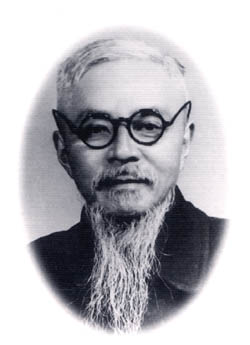Views
m |
m |
||
| Line 8: | Line 8: | ||
|associates=Notable Associates: | |associates=Notable Associates: | ||
* Hóngyī [[弘一]] | * Hóngyī [[弘一]] | ||
| + | * Lǐ Yuánjìng 李圓淨 | ||
|editor-name=Erik Hammerstrom | |editor-name=Erik Hammerstrom | ||
}} | }} | ||
| Line 24: | Line 25: | ||
During the mid-1920s, Fēng saw Hóngyī several times. Under his encouragement, Fēng formally took refuge in Buddhism at his private studio under Hóngyī on September 26, 1926 (which was his 30th birthday according to ''suì'' reckoning). | During the mid-1920s, Fēng saw Hóngyī several times. Under his encouragement, Fēng formally took refuge in Buddhism at his private studio under Hóngyī on September 26, 1926 (which was his 30th birthday according to ''suì'' reckoning). | ||
| + | |||
| + | |||
==Important Works== | ==Important Works== | ||
| Line 30: | Line 33: | ||
* ''Zǐkǎi mànjí'' 子愷漫集, vol. 2. 1926. | * ''Zǐkǎi mànjí'' 子愷漫集, vol. 2. 1926. | ||
* ''Yīnyuè rùmén'' 音樂入門. 1926. | * ''Yīnyuè rùmén'' 音樂入門. 1926. | ||
| + | '''With Hóngyī and Lǐ Yuánjìng 李圓淨''' | ||
| + | * ''Hùshēng huàjí'' 護生畫集. 1928. | ||
==Notes== | ==Notes== | ||
Revision as of 05:03, 6 April 2010
Fēng Zǐkǎi 豐子愷 (1898-1975)
|
Notable Associates:
|
|
Fēng Zǐkǎi 豐子愷 (1898-1975) was an important artist and illustrator of the Republican period. He was also an active lay Buddhist.
Contents |
Biography
As a youth, Fēng received a classical education at the Confucian academy run by his father. When Fēng was 13 suì 歲, the academy was turned into a modern school, and he became one of the first students. He was first in his class and in 1914 he became a student at a middle school in Hángzhou1 杭州, where he studied art under Lǐ Shūtóng (who later became the famous artist and monk Hóngyī 弘一). Lǐ recognized Fēng's artistic talent and had a major impact on his later development. While in school, Fēng also studied Japanese. In 1918 Lǐ Shūtóng ordained in Hángzhōu. Before he did so, he gave some of his work and supplies to his senior students, chief among which was Fēng.
Fēng graduated in July of 1919, whereupon he and several of his classmates moved to Shànghǎi 上海 where they worked at a new school. Fēng taught in the art department and helped establish the Chinese Fine Arts Educational Society 中華美育會, which published the magazine Měiyù 美育.
In the fall of 1921, Fēng went to Japan to study oil painting. At the time he also joined groups dedicated to studying Western musical and painting techniques. After ten months in Japan, lack of funds forced Fēng to return to China. He worked in Shànghǎi for the year before taking two positions teaching in Níngbō 寧波.
In May, 1925, the magazine Wénxué zhōubào 文學周報 published a special collection of Fēng's work, which was published as the monograph Zǐkǎi mànhuà 子愷漫畫 by Kāimíng Books 開明書店 the following year. This was Fēng's first book, and the first Chinese book to us the word "mànhuà 漫畫" in the title. That same year, the Lìdá Study Association 立達學會 was formed by Fēng and his friends along with the associated Lìdá Middle School 立達中學 (the name was changed to the Lìdá School 立達學園 in 1926).
During the mid-1920s, Fēng saw Hóngyī several times. Under his encouragement, Fēng formally took refuge in Buddhism at his private studio under Hóngyī on September 26, 1926 (which was his 30th birthday according to suì reckoning).
Important Works
- Zǐkǎi mànhuà 子愷漫畫. 1925.
- An updated version of this collection can be viewed here.
- Zǐkǎi mànjí 子愷漫集, vol. 2. 1926.
- Yīnyuè rùmén 音樂入門. 1926.
With Hóngyī and Lǐ Yuánjìng 李圓淨
- Hùshēng huàjí 護生畫集. 1928.
Notes
References
- Barmé, Geremie R. An Artistic Exile: A Life of Feng Zikai (1898-1975). Berkeley: University of California Press, 2002.
- Shì Dōngchū 釋東初. Zhōngguó Fójiào jìndài shǐ 中國佛教近代史 (A History of Early Contemporary Chinese Buddhism), in Dōngchū lǎorén quánjí 東初老人全集 (Complete Collection of Old Man Dongchu), vols. 1-2. Taipei: Dongchu, 1974 Pp. 2.722-730.
- Yú Língbō 于凌波, ed. Xiàndài Fójiào rénwù cídiǎn 現代佛教人物辭典 (A Dictionary of Modern Buddhist Persons), 2 vols. Taipei: Foguang, 2004. Pp. 2.1694a-1697b.
